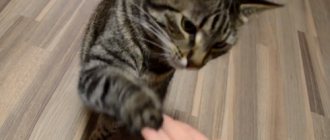Cats can be trained and this is not news to you, but many owners are tormented by the question “How?” How to make this “striped face” perform tricks and understand commands? First, forget the word “force”; training a cat, like training a dog, is a team effort that brings pleasure to the animal and its owner. Are you wondering how to teach your cat commands? Have you noticed the talent for performing in your “fluffy little thing”? 10 minutes of theory and you are ready to practice.
Basics of education
The optimal age to start training, as we have already said, is six months. Since it is at this time that it is easier for the pet to master commands. The basics of education, along with the breed, play a fundamental role in training. Strict adherence to behavioral norms and sincere relationships between owner and pet are also a priority. It is advisable to begin preparations by accustoming the kitten to the rules established in the home.
The most important rules for starting successful training:
- It is necessary to buy the pet its own toys, otherwise for active entertainment the kitten will play with the things of the owner and his family.
- For sleep and rest, a young cat needs to have its own place. She should not play or doze on the master's beds and sofas.
- Just like a child, you should never yell at kittens or, especially, hit them. A stern and slightly raised voice will be enough for them to understand that they are being punished. Animals are good at distinguishing human intonation and remembering what they are not allowed to do.
- From the first months, the kitten must know the location of its plate. You cannot throw food from the table, otherwise he will jump on it and steal food.
- The cat must know that the litter tray is in the same place and needs to go only there. The first time he needs to be placed in the tray and not allowed to leave for 2-3 minutes.
- The psychology of communication is very important. You need to establish a trusting relationship with your domestic cat so that training does not cause problems in the future. It is worth paying more attention to the kittens, playing with them, stroking them and trying to reward them for following orders and good behavior.
When and where to start training a cat, procedure
You need to start, of course, with preparation. First, observe your pet. If he carries a toy in his teeth, then you should try to teach him the “fetch” command; he loves to jump - introduce a jump through a hoop or onto the owner’s shoulders. When a pet touches its owner with its paws, in order to attract attention, you can enter the command “give me your paw.”
It’s worth paying attention to the cat’s habits. When he gets tired, how long he can play, what food he likes. All these elements of training will allow you to achieve better training results without much effort.
It must be taken into account that when an animal does not like something, it will be almost impossible to force it to do it. It is important to present training as a game and as part of communication with the owner.
How to wean a cat from unpleasant actions
If your cat likes to do some actions that are unpleasant for you, you can also wean her from this.
For example, consider a situation where a cat jumps on the kitchen table, hoping to profit from something there. You watch for the cat at the moment when it heads to the kitchen and stand behind the door so that the cat does not see you. At the moment when the cat has already started jumping, you spray water on it from a specially prepared sprinkler. The cat runs away and reflects on what happened. She doesn't associate the trouble with you because she didn't see you. She understands that the trouble happened precisely at the moment of the jump, so she concludes that it is impossible to jump on the table. You can also act if the cat begins to use completely inappropriate places as a toilet.
Source
Operating rules and errors
Any training is based on the development of conditioned reflexes to unconditioned stimuli, for example, a voice or food. You can start training only in a good mood, and both the cat and the owner must be active. It is better to start when the animal is cheerful, cheerful and slightly hungry, and wants to play.
There is no need to create special conditions; all training takes place in a familiar environment, at home. The training itself comes down to a simple condition: the cat did some action and was rewarded for it.
- stroking, scratching, affectionate words;
- favorite treat;
- both.
You cannot force a cat to do something, it will end in failure, the animal will simply run away and then stop obeying. You cannot exhaust your cat with endless repetition of the same order. He will quickly get tired, and then any lesson will be disgusting. The lesson should take no more than 5 minutes, and even better, repeat what you have completed 3-4 times.
The best results are achieved after several small training sessions per day with a long rest.
To train your cat, be patient.
Weasel is the key to success in training
You will have to wait for some time for the moment when the animal does what you expected of it. It is precisely at this moment that the command should sound, according to which the trick will be performed in the future. These actions must be repeated many times until the pet remembers your words and begins to compare them with the necessary movements.
When training cats, you need to know that their motivation disappears very quickly. To begin with, performing all actions similar to what you want should be rewarded with a treat. Subjecting an animal to punishment or forcefully trying to force it to perform a task that is not to its liking is very cruel and unacceptable. It is better to carry out training with a hungry animal, then it will quickly understand that food comes to it as a reward for a successfully completed trick.
The learning process should consist of small stages, so it will be easier for the cat to understand the owner’s requirements and assimilate them.
What commands should you start training with?
Cat training begins with simple, easy and memorable commands. If the owner has the free time, desire and patience necessary to train the animal, then you can begin to practice.
To me
A simple command, thanks to which the cat understands that he is being called for a treat. You need to pick up the pet, bring it to the plate and say a voice command, calling its name.
Stand
You need to bend over and say the instructions loudly. Then praise the pet, stroke it and repeat everything described above again.
Tricks
If the decision to train a cat has been made, you need to be patient. It is necessary to take into account the waywardness of pets.
Bounce
- Place the animal on a chair.
- Place another one nearby and place a piece of food on it.
- When the cat makes a jump, you need to pronounce a short and concise decree, for example “Up”.
- After landing, don’t forget to praise the stuntman.
When the cat learns to react quickly, you can try giving food from your hands, repeating the commands step by step. The transition to the next tricks is possible only when the animal learns to instantly carry out the order. Frequent rehearsals are needed to consolidate the material.
Sit
The “sit” command is useful for restraining a cat, for example, during medical examinations. With regular encouragement of sitting still, the pet will learn to wait for food without getting in the way. How to teach:
- Show the animal a piece of treat and entice him to come to you.
- After the cat has approached, raise your hand slightly above his head.
- Repeat the trick on a regular basis, remembering to say the command. It will be short and catchy - “sit down.”
We must remember that cats should not feel pressure. They are too proud to follow human orders, so the command must be pronounced calmly and confidently without raising the tone.
Bring it
Entertainment team. You can demand to move objects in your teeth by initially throwing this same toy. Cats love foil, so you can start training with a shiny piece rolled into a ball.
- You can play with your cat with a small and light toy.
- Throw her nearby.
- When the animal takes the toy in its teeth, say the command.
- Don't forget to praise the cat and reward it with a treat.
- When she wants to eat, she will bring the toy to her feet.
Yuri Kuklachev with his cat
Lie
This command is an indispensable skill when visiting the veterinarian. The cat needs to be seated, shown a tasty morsel and slowly lowered down. Of course, the animal’s head will fall behind it, then you need to move the food to the side. Ideally, the pet should lie down on its own. As soon as the cat lies down, you can praise him and treat him with food.
Mr. Cat recommends: TOP 5 easiest cat breeds to train
Unfortunately, some pets do not pay attention to any commands, much less tricks. But there are also breeds of animals that in a few months can become participants in circus performances. Here is their list:
Abyssinian
The differences are in heightened curiosity, sociability and fearlessness. Due to their muscular body and long fingers, they perform difficult tricks with ease.
American Shorthair
Pets of this breed quickly master many commands and become accustomed to the tray.
Bengal
Active, fast, playful cats, not afraid of water. Amenable to training, they do not refuse goodies.
Siamese
One of the most loyal breeds, these cats are constantly on the heels of their owner. When having fun, he can make a mess and likes to watch TV. They are easy to teach commands and perform all tricks perfectly.
Savannah
A hybrid that resembles a tabby cat. He has a playful character, often gets rowdy, climbs into cabinets, throws off various utensils, and can grab his leg. It is interesting to train them; they perform all commands with varying difficulties.
The above list of cat breeds that can be trained is quite arbitrary. Even ordinary kittens can become the best trick performers. Therefore, there is no need to focus on a specific expensive breed; it is better to train and educate your pets yourself.
Training and education
The terms “training” and “education” mean the process of developing certain reactions and behavioral skills in a cat, however, there are fundamental differences between them. Training is a systematic influence on a cat in order to develop certain skills in it. Through repeated repetitions, reinforced with encouragement, the pet is taught to follow commands.
Education is a broader concept; its goal is to instill rules of behavior in the cat. This is an integral aspect of pet ownership, as wayward animals sometimes do things that their owners consider unacceptable. This process begins from the moment the cat appears in the house and does not end throughout its life. Unlike training, education is not about teaching an animal to follow commands, but about developing an understanding of what is bad and what is good.
Is it worth teaching?
It all depends on the owner: if he wants to show off his pet’s capabilities, let him become a trainer.
In principle, any cat living next to a person performs the necessary actions without any training, having learned to accurately determine the owner’s mood.
For example, some fluffies allow themselves to climb onto their owner's lap only after a special signal - an inviting clap on the legs - and it is unlikely that anyone taught them this purposefully.
The training process also has its not always obvious advantages:
- the opportunity to establish cat-human relationships;
- get to know each other better;
- develop the pet’s possible talents;
- adding variety to a cat's monotonous life;
- the same physical activity that is vital for some predators.
Are all cats trainable?
Just like people, learning abilities vary from cat to cat. Some learn commands quickly and easily, while others have difficulty mastering them. Even an animal that is unable to learn can be taught simple commands, but the training process will be longer and more complex. Intellectual abilities, memory and devotion to the owner play a big role.
Cat trainer Yuri Kuklachev
It is believed that some breeds are easier to train than others. The first include the Thai, Siamese, Abyssinian and Anatolian cats, Burmese, Savannah, Kuril and Japanese bobtails. Practice shows that the most important role is played not by the breed, but by the character of the pet. The famous trainer Yuri Kuklachev notes that outbred cats often show more impressive results than purebred cats, since they are more loyal and obedient.
Are all cats trainable? With rare exceptions, yes. Almost any cat, even one not brilliant with intelligence, will drop what it’s doing and run to the kitchen when it hears the clink of a bowl, the rustling of a pack of food, or the words “eat.” The pet has built a logical connection - when it runs towards the sound, it receives reward in the form of food.
What breeds are the best to train?
All breeds handle training differently—and even have different training abilities. Outbred cats differ from purebred cats in their docile nature and quick perception.
Who else stands out for their intelligence and good understanding of people:
Scottish lop-eared
- cats of this breed love to move, and they are also very attached to their owner and love to spend time with him. This is an optimal breed for training - Scots are able to learn more commands and tricks in less time.
Thai cat
- active, receptive and perfectly captures the intonations of the owner’s voice. It is easy to learn and trainable due to its abilities.
Cornish Rex
- cats of this breed perceive training as a kind of game. And they love to play more than others, so they learn well during such games and get less tired of them.
Abyssinian cat
- an intellectual among his relatives. These cats are able to learn some commands and tricks even without special training or training, simply in the process of playing or communicating with the owner.
Outbred cats exhibit different learning abilities. Basically it all depends on their character and previous life. A cat raised in a family will understand a person better than one that was taken from the street in adulthood.
In addition to the breed, it is necessary to rely on the character of a particular animal - there are lazy Scots and surprisingly active ragdolls. If desired, any cat can be taught at least a small trick.
How to properly train a cat at home?
Training is a long process; you should not expect success from the animal in the near future. To train a cat, you need to be patient and not force things. Excessive persistence of the owner will only scare away the pet. It is necessary to prepare a treat that will be used as a reward: a favorite treat, small pieces of meat or cheese (3-4 mm in size).
To determine which commands your pet will learn, you need to watch him and highlight the games that he likes the most. If he likes to carry toys in his teeth, he can be trained to fetch things abandoned by his owner. Does your cat love to jump on shelves? He will love jumping through a hoop or from one object to another on command. It is important to choose the right place and time for training, taking into account the condition and mood of the pet. A cat is a wayward animal, and forcing it to do something it doesn’t want will not work.
Optimal conditions for training: place, time, condition of the animal and trainer
Classes begin in the morning or evening, when cats are most active. They are carried out a few hours after eating - a well-fed pet will prefer to rest. The cat must be healthy and in a good mood. If you feel unwell, or for several days after vaccination, classes are not held. If the pet does not show any desire to exercise, the training is postponed.
The cat will only follow the commands of the person it trusts. She usually becomes more attached to one family member than the others. He should be the one conducting the classes. The positive attitude of the owner plays a significant role, because cats subtly sense the state of the owner. You should not start training if you are feeling unwell or in a bad mood. Classes are held in a small, quiet room where there is no one except the owner and the cat.
Training methods (painful, rewarding, imitative)
There are several training methods:
- Painful. Based on the use of irritating and pain-causing factors. To force an animal to do what is required, it is forced to experience discomfort and pain. A collar with a stun gun is designed for such training. It is equipped with electrodes and a remote control. When the button is pressed, the cat receives an electric shock.
- The imitative method is based on the innate instinct of animals to imitate their own kind. For example, kittens, watching their mother, begin to adopt her habits over time.
- The incentive training method is based on reinforcing acquired skills with positive emotions - when the pet has completed what is required, it receives a reward (treat, praise). The result is achieved through repeated repetition and reward.
How to teach a cat to jump on your shoulder
How to train a cat?
As for the training itself, it should take place in stages, and the most important quality of the trainer should be patience: sometimes for training it is enough just to wait until the cat performs the action you want and at that moment say the appropriate command. The cat must remember the sound of the action and its course, after which it must be encouraged.
How to teach a cat different tricks?
The “sit” command needs to be taught to a cat patiently. Place the animal on the floor and wait until it wants to sit down, then immediately say the command. When the cat responds correctly, give it a treat, and if it is stubborn and remains standing, press your hand on the back of its body, as if calling it to sit and repeating the command.
You can also teach your cat the commands “Stop!” (block the animal’s path with your hand and say the command) and “Bring it!” (start with objects that cats will most likely run after), as well as jumping through hoops. In addition, you can train your cat using other commands and tricks, but do not overtire the animal. Sometimes it is better to postpone training for a while so that the cat does not develop an aversion to exercise.
CENTERY FOR MAINE COON CATS – “CHRISTMAS YARD”
Training a cat at home
How to train a cat at home
I keep two Don Sphynxes - a 3-year-old cat and his seven-month-old daughter. When guests come (and this happens quite often), the signature performance is the demonstration by our pets of some skills that are unusual for their everyday life. If you have a kitten and you like to play with it, then this can be done with pleasure and benefit. I would like to share some aspects of cat training from personal experience (albeit amateur). Once upon a time, when I was still living with my mother and we had a simple half-breed cat, I read in a book that the optimal age for training cats is 6 months. Our cat was just six months old at the time; her fangs had just changed (this is also a sign that the cat is about 6 months old - information for those who do not know the exact age of their kitten). And I was easily able to teach the command “sit” to “Up!” – jump on your hind legs, give a paw (each separately), lie down and spin from side to side. Now 10 years have passed, the cat has become fat and lazy, and now I’m not around and there’s no one to train her, but she does a couple of commands easily: “paw” and “lie down.” I continued this experience later with my sphinxes: 2.5 years ago with a cat, now with a seven-month-old cat. So, the kitten should be about 6 months old. We train for our favorite food (I use vitamins for cats). The main thing is to be gentle, but persistent, no screaming, much less hitting (firstly, beating animals is bad, and secondly, cats will never do what you want if you beat and scare them). I taught the cat several times a day, now the kitten needs only 1 time a day. My technique:
The command “Sit!”: I hold the treat over the kitten’s nose so that he reaches for it, and with the other hand I lightly but persistently press on his back near the tail so that he sits down. The kitten may even rise up on its hind legs - this will be an “additional bonus” to this command. The command “paw” or “give me a paw”: I let you smell the yummy and say “paw”, while I take this paw in my hand and feed this yummy directly from my hand, without letting go of the paw. Same with the other paw. The “lie down” command: I let you smell the treat, then I say “lie down” and push the cat so that it lies on its side, then I reward it with food, holding the kitten in a lying position. I accompany the “lie down” command by tapping my finger on the place where the kitten should lie down (so that later the cat will lie down only when tapping is done). If desired, you can also teach the kitten to roll from side to side. The scheme is the same: yummy - command - action - yummy.
In our family, the cat prefers to “give a paw”, and the kitten funny follows the command “lie down” (my friend saw this and was “shocked”). Decide, if you want to get results in this matter, then you need to be patient and try.
Source
How to teach a kitten or an adult cat some commands?
You can start training at home when your pet reaches 2-3 months of age, although some experts advise starting training at 8 months, arguing that very young kittens are not able to understand what is required of them. Young animals are more curious and receptive, their brain works more actively, so it is easier to train them than adults over 1.5 years old, especially older ones. Training is carried out in stages, starting with simple commands and gradually moving to more complex ones.
"Sit", "stand", "lie down"
The simplest commands are “sit”, “stand” and “lie down”. To seat your pet, you need to place the treat behind his head and lightly press on the back of his body. You can force the cat to lie down by holding the treat low and gently pressing on the back. In order for the cat to assume a standing position, the treat is brought to a level just below the nose and the pet is lifted by the stomach. After a successfully completed action, the command is repeated, the student is praised and given a tasty morsel.
"To me", "place"
Teaching your pet the “come to me” command is the easiest way. They call him by name, adding the words “to me.” The cat that approaches is rewarded with a treat. Teaching an animal to go to its bedding or house on command is somewhat more difficult. He is lured to the right place with a treat or toy, after which the command is pronounced (“place!”) and he is given a treat.
To make the bed more attractive to the cat, place his favorite toys nearby or sprinkle it with catnip. The pet should like the location of the resting place. You need to watch him and find out where he rests most often. It should not be placed in a draft or in a passage.
“Jump” (over an obstacle or into a hoop)
Cats that love to jump from place to place will not be difficult to teach to jump on command. To do this, you will need stable objects - a sofa, an armchair, a chair, a table. The pet is placed on one of them, and the treat is placed on the other. When the cat jumps after him, they say the word “up” and praise him. The treat is then placed on the first object. After the cat has jumped back, they pretend that the treat is again placed in the place it just left. The animal receives the reward for the completed jump from the hands.
Then the task is made more difficult by placing an obstacle or placing a hoop. These items should be familiar to the cat. If they are new, you should leave them in the room for a couple of days so that the animal can sniff them thoroughly and get used to them.
"Give" ("bring")
To teach a cat the “give” command, you need to take its favorite toy (ball, mouse), which it often carries in its teeth. It is thrown a short distance (0.5–1 m), saying the word “bring.” After it is in the mouth, the animal is lured towards itself with a treat. You can tie a rope to the mouse and pull it, showing the cat the right direction. If a cat drops a toy after seeing a treat, you should not give it a treat.
“Ask” (complicated version – “dance”)
The essence of the command is for the cat to stand on its hind legs at the owner's request. To do this, the cat is given a treat from the palm of his hand, each time raising it higher and higher - so that he has to tear his forelimbs off the floor and try to get the treat. After the exercise has begun to work out well, you can teach your pet to walk and spin on its hind legs, as if dancing. This is achieved by moving a high-lying treat.
How to train a kitten to walk on a harness
A domestic cat will never refuse new experiences, and there are usually not many of them in an apartment. Therefore, you can instill in your pet such a useful habit as walking outside. For safety, you must use a special harness. Pet stores offer a large selection of such accessories.
Starting at 6 months, get your kitten used to wearing a harness. Wear it for a short time at home, leave it near toys, and if the animal is interested, you can gradually take it out for short walks. First, walk around with the kitten in your arms, and then you can lower it to the ground. At the same time, hold the leash firmly, but do not pull on it. You can take toys or treats for a walk. If the pet is too shy and refuses to explore the street world, well, you will have to come to terms with it.
Before your walk, be sure to give your kitten all the necessary vaccinations. Regularly prevent the appearance of worms, fleas and ticks. Wipe your animal's paws after going outside.
Is it possible to train a cat
Mustachioed sneaks with a cunning look and hunting habits are not dogs devoted to their master and ready to obey. No offense will be said to the barking brothers. The small predator has a natural desire to dominate. A representative of the cat tribe cannot be forced, but she can be persuaded. Then she will fulfill the person’s request. Attachment to the owner is a vulnerable character trait of a proud animal, which allows him to instill unusual skills.
Video: pet turns off the light
The debate about whether cats can be trained has been going on for a long time. There is no consensus on this matter among owners, breeders and felinologists. It cannot be any other way: everyone makes their own arguments based on personal experience. For example, one argues that animals are not teachable. And he motivates with the story that he was unable to develop a conditioned reflex in his pet to the “Voice” command. The owner said this word for half an hour, showing the tasty “prize” to the adult Briton, and he looked at the man’s efforts with bewilderment. Even repeating the order along with “meow” turned out to be useless. Defenders of cat abilities say: pets feel a person so much that they guess the command even before it sounds. They are just pretending, playing at submission. Or they try to please in the hope of getting something tasty. And the owner is happy that the necessary action has been completed, and considers himself a tamer. The third judgment is also based on the example of the behavior of an already trained cat. Knowing exactly the meaning of the order, she refuses to carry it out. Not out of forgetfulness, but on purpose. We have to conclude that standard training with unquestioning execution of a person’s command is impossible. When the opportunity arises, your pet will always show a headstrong character.
When to start training
A four-month-old kitten already responds to its name when you feed it or call it. At six months of age, the baby begins to play and run for a long time. He is curious, knows no fear and trusts those around him. Without wasting time, the owner should take a closer look at the ward, his habits and favorite toys. Observations will help you create a plan for future training. This is how they work in circuses.
The carefree toy begins to be taught simple commands, which do not require physical effort, in their “teenage” years. At 7–8 months the animal is ready for dialogue with humans. To show his affection, the furry parodist will try to fulfill the owner's demands.
Rules for working with animals
They train in a quiet room, staying alone with the pet. Lesson duration is 10 minutes with a rest break. Each action is practiced 4–5 times. A program to introduce your furry pet to new skills doesn't have to be stressful. You cannot engage in training after vaccination, as well as in case of any painful conditions. Do not learn two tricks at once, so as not to confuse the animal. Remember that training abilities vary.
Tip: train your pet during the day or evening, 3-4 hours after feeding. A hungry animal will not want to work, but a well-fed animal will prefer to wash itself and take a nap.
What you will need
Instead of a spacious circus arena, any flat area that is convenient for you and your cat will do: a floor with a rug or a grassy lawn near the house. For more complex tricks, you will have to prepare special furniture. Select toys: a tennis ball or a skein of woolen thread.
Cat Training Basics
There are a few basics needed to successfully conduct cat training. If these conditions are met, classes will be comfortable for the pet and calm for the owner.
At what age should I start?
There is an established opinion that kittens begin to understand what their owner requires of them from about three months. Accordingly, the optimal age for any training is considered to be from three months to a year. In this case, the peak of activity and perception occurs at 7-8 months. At the same time, the kitten shows a tendency towards certain actions and tricks.
Techniques and techniques
Training a cat must take place in a calm environment, preferably one on one. It is optimal to conduct classes in the daytime or evening, no later and no earlier than 3-4 hours after feeding. The event should be comprehensive, go from simple to complex and not overtire the cat.
The room should be spacious and comfortable for you and the cat. There should be no distracting objects or factors. It is also better to prepare inventory in advance.
Training should take no more than 10 minutes per approach. Number of approaches – 2 or 3 per day. Each “trick” must be repeated at least 4-5 times. This will help bring the execution of the command to automaticity.
The cat needs to be encouraged. The reward is pre-prepared pieces of meat, fish or other delicacies. Those foods that the cat will have to chew are not suitable - it will be distracted from the main training. It is necessary to reward with food exactly at the moment when the cat has performed the trick, but no later than 10-20 seconds later - otherwise the pet will not understand that the reward is connected with its success.
It is necessary to pet the cat and show attention as additional encouragement. Over time, when the cat learns to clearly and quickly follow commands, food should be rewarded every third to fifth time, and the rest - only affection.
Necessary items and materials
Simple tricks do not require special training from the owner or special furniture.
Balls, bows on a string, a hoop (with a diameter of no more than 35 centimeters), a laser pointer, a container for rewarding treats, a skein of woolen thread (which the animal cannot chew off and swallow) may be useful.
The set of items must be selected in accordance with the commands and tricks that were chosen for study. For complex elements, you may need cabinets and chairs or other comfortable furniture - at the discretion of the owner.
All things should be familiar to the cat. If you bought something specifically for classes, first let your pet sniff the new thing. Otherwise, he will be distracted by the introductions and will not pay attention to commands.
Common Mistakes
There are several common mistakes that owners make when training their cats. What not to do:
Delay classes, increasing their time by more than 10 minutes. Cats quickly get bored with the monotonous execution of commands and tedious games - they begin to get bored and even feel disgusted.
Forget about rewards or give rewards at the wrong time. It is important that the pet receives the reward in a timely manner - this will help him establish the correct cause-and-effect relationship. If you are late with rewards, the cat may not understand why she was praised.
Hurry or hesitate to pronounce a command. If an animal carries out a command before a person can pronounce it, there may be a misunderstanding of what was required of it or what it was rewarded for.
Basic commands for cats
Start teaching your home artist with simple instructions. First master: “Come to me,” then “Sit” or “Give me your paw.” Walking like a snake also does not require much physical effort. When your mustachioed friend can stand for at least 5 seconds without leaning on anything, start jumping exercises.
Sit
Hide a couple of pieces of food in your fist. Cross your arms over your chest, letting your cat know you have a treat in store. Wait until she sits next to you, taking the pose of an Egyptian sphinx. Then immediately say the command and reward with a treat. Then raise your palm above her head and force her to stand. Repeat the exercise two or three times, ensuring that the pet sits at your command for 5-6 seconds and reinforce obedience with a piece of food and praise.
Lie
The easiest way to teach a furry fidget this trick is when he is tired of playing and wants to rest. Stroke the cat on the back so that it assumes a horizontal position. Name the team, don’t forget to give them a piece of food. Unfortunately, this method is used only on occasion and is not suitable for daily practice.
Learning the command “Lie down” begins after following the orders “Come to me” and “Sit”
With the usual method of training, a sitting pet is lured with food, lowering the piece almost to the floor. Of course, first the animal will try to catch a portion of food with its claws. The owner, without wasting time, must push the front paws so that the cat sits on its stomach. All that remains is to say: “Lie down!” We give the pet a tasty reward in such a way that he takes it without getting up. Otherwise, the animal will get confused and will not be able to understand what needs to be done.
Stand
The trick is taught on a chair with a backrest so that the animal, especially a young one, is not afraid of losing its balance and falling. Show the cat a piece of food, holding it in the fingers of your right hand. They turn away and quickly transfer the treat to their left palm. The free one makes a conditional gesture over the pet's head, forcing it to stretch up and stand on its hind legs. She will try to grab your hand with her front ones. Order: “Stop!” After two seconds, give the prepared piece of food, praise and caress.
Give me your paw
The command is executed when your furry pet sits next to you. Hide a treat in your clenched fingers. Let her sniff the fist and try to get the food. Press the raised paw into the palm of your free hand, give the order and reward the “student”.
A piece of treat in the pet's field of view makes the training process easier
In some cases, the trainer himself has to take hold of the clawed metacarpus, showing the cat what action is required of it. The forced method of explanation is used if the animal tries to get food with its teeth.
Video: how to teach a cat to say hello
Usually the pet easily learns the command and demonstrates a new skill within a week.
To me
To practice the skill, choose a moment when your mustachioed friend is at a distance but sees you. Show the prepared reward, say the name of the pet with the addition of the command “Come to me.” If you run up right away, please them with something tasty and say: “Good” or “Bravo”. Distract the purr with something and repeat the order 2-3 times, no more.
Bring it
While frolicking, kittens often drag their favorite toys around the house. Having matured, animals retain this habit. The trainer can only improve it. It is enough to pick up a ball of thread from its mouth and throw it at a distance of no more than a meter. If your pet grabs a rolling ball and moves away, follow it. Saying: “Bring it,” remove the object from the animal’s mouth and treat it with food.
The difficulty of this task is that the fast runner should not place the toy on the floor near the trainer’s feet. He needs to return with the item and give it to the owner. To get the desired result, you will need patience.
Jumping through a hoop
To prepare the trick, decorate a plastic or cardboard circle with bright fabric. The device should be familiar to the cat and not cause fear in it. Place the hoop in front of the future circus performer, holding it with your right hand. Use your left hand with a piece of cheese to lure your pet to step over the obstacle. Having said: “Up”, hand over the treat.
When the animal can freely walk back and forth inside the device, raise the ring 5–7 cm. Reward your pet every time after a jump. Gradually increase the height of the hoop above the mat until it reaches half a meter.
To teach tricks, choose a secluded place so that the pet is not distracted by anything.
Kiss
The trick is intended for affectionate animals who love to express their sympathy for humans. Before training, lubricate the tip of your nose with pate. Sit back and call the cat. Let him jump into your lap. Take the purring purr in your arms and stroke it. Then tilt your head towards his muzzle so that your noses touch. When your furry pet starts licking the “bait”, say: “Kiss” and do not skimp on words of approval.
The “Kiss” command is taught to vaccinated animals that do not have access to the street.
Somersault
Rolling from one side to the other is a natural ability of the cat tribe. This is an invitation to play and a desire to share a great mood. A person can only complicate the task by getting a circus act. After the “Lie down” command, bring the food hidden in your fingers to your pet’s face. Slowly move your hand behind the withers, then along the back to the tail. Wanting not to lose sight of the treat, the cat will roll over, stretching its front paws. Lightly tap your palm on the floor so that the purr is back on his stomach. Give the command: “Somersault” and reward for execution.
Snake
Walking a trained cat between its handler's legs is an age-old trick. He always makes the audience smile. To teach your animal this skill, choose a moment when your pet is nearby and step forward. To make the learning process easier, take the food supply in both hands. Lure with a treat by moving your palm to the side of your knee. When the pupil goes around the leg, move on and continue the lesson, repeating the word: “Snake” or “Snake” and periodically rewarding with food.
Progress of training
The main commands that pets are taught are “come”, “fetch”, “sit” and “jump”. But it is more logical to divide commands into simple and complex.
Simple tricks
Simple commands do not require complex combinations. It is best to start learning with them.
"Sit"
To run this command, follow the instructions:
- Show your pet a treat.
- Say loudly and clearly, “Sit.”
Based on the structure of the body, the cat will have to sit down, because it will raise its head to reach the tasty morsel. After completion, we praise and give a treat. This command must be taught as the animal moves. Move a few steps away from the cat, and as soon as he starts to approach, lift the treat up.
“Sit” is the simplest command that cats learn with pleasure if you hold a delicious piece of meat above their head.
"Lie"
The "down" command is also based on the animal's anatomy. After you have taught your cat the previous command, you can begin to “lie down.” We say: “Sit,” then carefully lower the piece of treat down. We make sure that the pet goes down after him. We move the meat slightly to the side and watch how the pet lies down. We give away a treat. If the cat does not lie down, we try to help him with his hand: lightly press on the back of the body or place his front paws on the floor.
"Stand"
The “stay” command is reminiscent of a cat’s position when it begs for food. We show our favorite a delicious piece, bend our arms at right angles, as if blocking her path. When she approaches, we raise the treat higher and say the command out loud. Once the cat learns to do the trick, you don't need to put your hands on it.
"Serve"
This command is also called "ask". Its essence is that the cat begs for a treat on its hind legs. We bring the treat to the animal’s nose, and when the pet begins to reach for food, we lift the piece higher and higher. At the same time, we say out loud: “Ask” or “Serve.” If you want and have patience, you can even teach your cat to walk on its hind legs.
The “ask” command is as easy as the “stay” command, they are very similar to each other
"Give me your paw"
Even the laziest cat can give a paw. This does not require active physical activity. Place a tasty morsel into your fist. We bring our hand to the animal’s nose and let it smell. Let him try to get the tasty treat in different ways. We are waiting for her to try to reach the food with her paw. When the cat touches your hand, say: “Give me your paw.” Then immediately give the treat. You can try the second training option: we say the command and take the cat’s paw ourselves. After constant repetition, she will begin to stretch her paw on her own.
Video: a cat is taught the “Give paw” command
Difficult tricks
You can start complex tricks only after mastering all functional (simple) commands.
"Jumping"
The cat can jump over a barrier, a hoop, or through your hands. First of all, make sure that the animal responds to its name. If all is well, we buy a hoop (30-40 cm). An embroidery hoop will also work. Let's proceed to the first stage. Place the hoop at a distance of 5 cm from the floor. We call the cat and help it go through the hoop, push it ourselves and say: “Up.” When the pet comes out, give the food. In the second stage, the cat must perform the jump on its own. Gradually increase the height.
"Bring it"
Not every cat learns the “fetch” or “fetch” command. We take our favorite toy, throw it and say the command. If the animal runs after a toy and takes it in its teeth, be sure to praise the cat, take the object and give it a treat. After repeated repetitions, the cat will understand what’s going on and will give the toy back himself.
There is a high probability that the cat will simply ignore the “fetch” command, but do not give up quickly, try repeating the exercise the next day
"Voice"
The ability to teach a cat to meow on command is also small. The best time for this is before feeding. Wait until your pet starts begging for food and meowing loudly. At this moment we say: “Voice.” After the cat meows again, give a treat.
"Kiss"
Very nice and pleasant team. We spread something tasty (pate) on our cheek. Let your pet smell it. We're leaving. Then we say the command and turn our cheek again.










